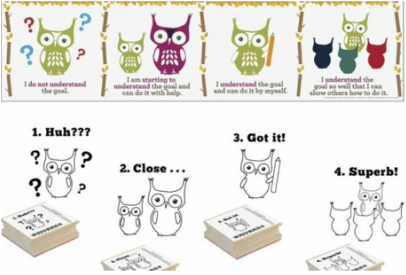
Use a learning goal and scale. Create a classroom culture in which students feel safe self-assessing and sharing their honest progress towards learning goals.
Set a purpose for each lesson by using a specific and measurable learning goal or objective written in student-friendly language. Remind students that a learning goal identifies what they will learn or be able to do by the end of the lesson. Tell students that they will be setting goals, reflecting on their understanding, and monitoring their progress toward these goals.Teach students how to show a numerical finger cue corresponding to the learning scale under their chins to rate their understanding throughout a lesson. Normalize misunderstanding by sharing a time in which you weren’t able to master something on your very first try and needed additional practice. Explain that honest ratings help you as a teacher because you are able to see what they understand and areas in which they need more help. Build this into the closure of each lesson before students complete their exit tickets.
I’ve found that using a learning scale has made a tremendous difference in my students’ motivation and investment in their own learning. They are accountable for their progress and take ownership of their mastery. Create your own learning scale banner or purchase Astute Hoot’s Learning Goal Banner & Stamps Kit.
Promote self-advocacy skills. Have you ever had a student that just sits like a bump on a log and stares aimlessly into space instead of asking for help? Teach your students how to advocate for themselves and ask appropriate clarifying questions by creating an Asking-for-Help anchor chart. This chart should consist of questions that students can ask when they need help or do not understand a goal, such as:
- May I please have more information?
- May I have some more time to think?
- Would you please repeat the question?
- Where can I find more information about that?
- May I ask a friend to help?
- Would you please give me another example?
- Where can I find that answer?
- Would you please show me another way to solve the problem?
- Would you please clarify that?
Create student portfolios. Portfolios are a great way for students to demonstrate growth and showcase their work as a holistic means of assessment. These are also powerful tools for communicating student performance during parent-teacher conferences. Create a checklist of work samples that you want to include in each student portfolio. For example, you may want to include a piece from each subject area that shows growth, one that shows mastery, a piece that each student is most proud of, and one that students are currently working on.
Explain to students how this is an ideal opportunity for them to demonstrate what they have learned and to share their learning goals with their families. Direct students to choose pieces of work within each subject area that they think exemplify their personal growth and progress. If using the stamp kit, tell students to stamp each piece of work with the appropriate stamp. Prepare students to justify and explain their ratings for each piece during the conference. Parents love seeing samples of student work and always moved when they hear children discuss their learning and progress.
Check out the blog 5 Tips for Creating End of Year Portfolios for additional ideas.
About the Authors
Jessica Murphy and Jennifer Zoglman are founders of Astute Hoot: Tools for the Wise Teacher. With a combined total of almost 30 years experience in early childhood and special education classroom teaching, early literacy research, and teacher coaching, they joined forces with Jennifer’s sister, Tina, an award-winning graphic designer, to create a dynamic cast of reading and math strategy animals. The strategy animals made their way into a group of targeted teaching and learning tools that have contributed to the creation of proficient readers and mathematicians in classrooms across the country! Check out their blog: www.astutehoot.com to see how they awaken the joy of learning in all students!


 RSS Feed
RSS Feed